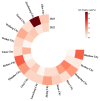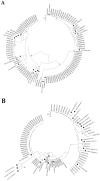Epidemiological and Genetic Characteristics of Sapovirus in Shandong, China, 2022-2023
- PMID: 40284912
- PMCID: PMC12031332
- DOI: 10.3390/v17040469
Epidemiological and Genetic Characteristics of Sapovirus in Shandong, China, 2022-2023
Abstract
Sapovirus (SaV) is a major pathogen responsible for acute gastroenteritis (AGE), and its incidence has been increasing in recent years. This study investigates the prevalence and the genetic characteristics of SaV in Shandong Province during 2022-2023, based on a surveillance network covering all age groups. Samples were obtained from a viral diarrhea surveillance network in Shandong Province during 2022-2023. SaVs were identified through quantitative reverse-transcription polymerase chain reaction (RT-qPCR). PCR amplification and Sanger sequencing were performed on positive samples, and whole-genome sequencing was conducted using metagenomic sequencing technology. Sequence analysis was conducted using BioEdit 7.0.9.0 and MEGA X, while statistical analysis was performed with SPSS 26.0. A total of 157 SaV-positive cases were identified, resulting in a positivity rate of 1.12%. The positivity rate for SaV was 0.75% in 2022 and it increased significantly to 1.42% in 2023. The highest positivity rates for both 2022 and 2023 were observed in November. The highest positivity rate was observed in the 3-5-year-old age group. In 2022, Dongying City had the highest positivity rate, while Zaozhuang City exhibited the highest rate in 2023. The incidence of vomiting in SaV-positive patients was significantly higher compared to SaV-negative patients (P = 0.002). Eight genotypes were identified in both the VP1 and RdRp regions. The complete genome sequence analysis of a GI.3 strain showed that NS1 (5.88%, 4/68) was the region most prone to amino acid variation, followed by VP2 (5.45%, 9/165) within the same genotype. SaV infections are more prevalent in cold weather, with young children being particularly susceptible. The SaV positivity rate in 2023 increased significantly accompanied by an increased diversity of genotypes, compared to that of 2022. The NS1 region exhibits the biggest variation within the same genotype, indicating that more attention should be paid to other regions besides VP1 in the future study. Ongoing surveillance of SaV is recommended for effective prevention and control.
Keywords: epidemiology; genome analysis; genotypes; sapovirus.
Conflict of interest statement
The authors declare no conflicts of interest.
Figures



Similar articles
-
Genotypic Analysis and Clinical Findings of Sapovirus-Associated Acute Gastroenteritis in Mie Prefecture, Japan, 2010-2022.J Med Virol. 2025 Jul;97(7):e70470. doi: 10.1002/jmv.70470. J Med Virol. 2025. PMID: 40590706
-
Incidence of human sapovirus outbreaks in Beijing, China, 2014-2021: predominance of genotypes GII.3 and GI.2.Emerg Microbes Infect. 2025 Dec;14(1):2521840. doi: 10.1080/22221751.2025.2521840. Epub 2025 Jul 7. Emerg Microbes Infect. 2025. PMID: 40548408 Free PMC article.
-
Increase in Sapovirus Infection in Korea After the COVID-19 Pandemic: A Six-and-a-half-year Retrospective Study.Ann Lab Med. 2025 Jul 1;45(4):420-427. doi: 10.3343/alm.2024.0458. Epub 2025 May 8. Ann Lab Med. 2025. PMID: 40336393 Free PMC article.
-
Global molecular prevalence and genotype distribution of Sapovirus in children with gastrointestinal complications: A systematic review and meta-analysis.Rev Med Virol. 2022 May;32(3):e2302. doi: 10.1002/rmv.2302. Epub 2021 Oct 8. Rev Med Virol. 2022. PMID: 34626019
-
Home treatment for mental health problems: a systematic review.Health Technol Assess. 2001;5(15):1-139. doi: 10.3310/hta5150. Health Technol Assess. 2001. PMID: 11532236
References
Publication types
MeSH terms
Associated data
- Actions
Grants and funding
LinkOut - more resources
Full Text Sources
Medical
Research Materials

